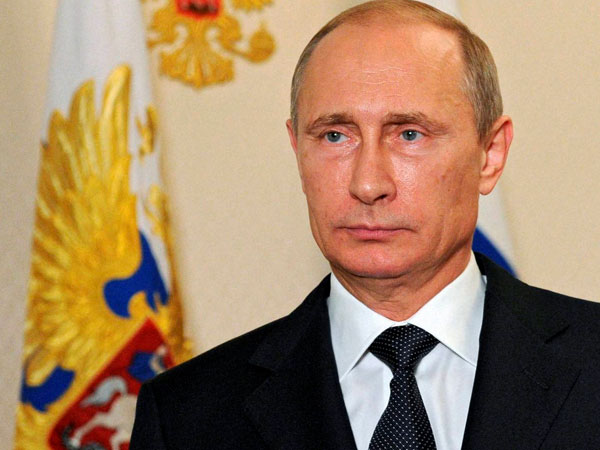
Vladimir Putin-led Russia may be in Ukraine to stay after 100 days of war
Initially, at least, annexing more land from Ukraine was not believed to be the main goal of the Russian invasion; now, Moscow is unlikely to let go of its military gains

When Vladimir Putin sent troops into Ukraine in late February, the Russian president vowed his forces would not occupy the country. But as the invasion reached its 100th day on Friday, Moscow seemed increasingly unwilling to relinquish the territory it has taken in the war.
The ruble is now an official currency in the southern Kherson region, alongside the Ukrainian hryvnia. Residents there and in Russia-controlled parts of the Zaporizhzhia region are being offered expedited Russian passports. The Kremlin-installed administrations in both regions have talked about plans to become part of Russia.
The Moscow-backed leaders of separatist areas in eastern Ukraines Donbas region, which is mostly Russian-speaking, have expressed similar intentions. Putin recognised the separatists’ self-proclaimed republics as independent two days before launching the invasion, and fierce fighting has been underway in the east for weeks as Russia seeks to liberate all of the Donbas.
The Kremlin has largely kept mum about its plans for the cities, towns and villages it has bombarded, encircled and finally captured. Kremlin spokesman Dmitry Peskov has said it will be up to the people living in seized areas to decide their status.
Increasing control
Ukrainian President Volodymyr Zelenskyy said this week that enemy forces now control almost 20% of the countrys territory. Before the war, Russia controlled 7%, including the Crimea Peninsula and parts of the Donbas. But in a video message marking the war’s first 100 days, Zelenskyy made it clear Ukraine will not submit easily.
“We have defended Ukraine for 100 days already. Victory will be ours,” he said.
US President Joe Biden, meanwhile, said he believes there’s going to have to be a negotiated settlement to end the war. Asked if Ukraine should give up territory in exchange for peace, the president said, “It’s their territory” and “Im not going to tell them what they should and shouldn’t do.”
Initially, at least, annexing more land from Ukraine was not believed to be the main goal of the invasion. It was widely thought that the Kremlin intended to install a pro-Moscow government in Kyiv that would prevent Ukraine from joining NATO and pulling further away from Russias influence.
But now, Moscow is unlikely to let go of its military gains, according to political analysts.
“Of course (Russia) intends to stay,” said Andrei Kolesnikov, senior fellow at the Carnegie Endowment for International Peace. “To Russia, its a pity to give away what has been occupied, even if it was not part of the original plan.”
Three-month siege
Russian forces captured much of Kherson and neighboring Zaporizhzhia early in the war, gaining control over most of Ukraine’s Sea of Azov coast and securing a partial land corridor to the Crimean Peninsula, which Russia annexed from Ukraine in 2014. They completed the takeover last month with the capture of the port city of Mariupol following a three-month siege.
Residents of the cities of Kherson and Melitopol took to the streets to protest the occupation, facing off with Russian soldiers in plazas. Ukrainian officials warned that Russia might stage a referendum in Kherson to declare the region an independent state.
Petro Kobernyk, 31, an activist with a nongovernmental organization who fled Kherson with his wife, said Russian security forces are cracking down on pro-Ukrainian activists. “Hundreds of pro-Ukrainian activists, including my friends, are being held in the basements of security services,” Kobernyk said by phone. “Those who actively express their position are kidnapped and tortured, threatened and forced out of the region. Russian forces keep people in an information vacuum, with Ukrainian websites no longer available.”
His claims could not be independently verified.
Some welcome takeover
But some in captured areas of Ukraine have welcomed a Russian takeover. “I’ve wanted to live in Russia since I was little, and now I realize I don’t even have to move anywhere,” said Vadim Romanova, a 17-year-old from Mariupol.
In Russian-occupied cities in southern Ukraine, people with pro-Kremlin views replaced mayors and other local leaders who disappeared in what Ukrainian officials and media said were kidnappings. Russian flags were raised, and Russian state broadcasts that promoted the Kremlins version of the invasion supplanted Ukrainian TV channels.
The Russian ruble was introduced as the second official currency in both the Kherson and Zaporizhzhia regions at least in the parts under Russian control and pro-Russian administrations started offering a one-time social payment of 10,000 rubles (roughly USD 163) to local residents.
Citizenship applications
An office of Russias migration services opened in Melitopol, taking applications for Russian citizenship from residents of the captured southern regions through a fast-track procedure. The procedure was first implemented in 2019 in the rebel-controlled areas of the Donbas, where more than 700,000 people have received Russian passports.
Top Russian officials started touring the regions, touting the territories prospects for being integrated into Russia. Deputy Prime Minister Marat Khusnullin visited Kherson and Zaporizhzhia in mid-May and indicated they could become part of our Russian family.
A senior official in the Kremlins ruling United Russia party, Andrei Turchak, put it even more bluntly in a meeting with residents of Kherson: Russia is here forever. Members of the pro-Kremlin administrations in both regions soon announced that the areas would seek to be incorporated into Russia. While it remains unclear when or if it will happen, Russia is appears to be digging in.
With agency inputs


